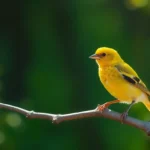Deep in the misty highlands of the Himalayas lives one of nature’s most spectacular creatures – the monal bird. We’ve all seen countless beautiful birds but nothing quite prepares you for the breathtaking iridescence of this pheasant that seems to have been painted by the gods themselves.
Also known as the Himalayan monal this remarkable bird isn’t just another pretty face in the avian industry. It’s Nepal’s national bird and holds deep cultural significance across South Asian mountain communities. With males displaying a kaleidoscope of metallic blues greens and purples that shift and shimmer in the mountain light the monal represents one of evolution’s most stunning achievements.
We’ll explore everything you need to know about these extraordinary birds from their unique behaviors and habitat preferences to their conservation status and the best places to spot them in the wild. Whether you’re a seasoned birdwatcher or simply someone who appreciates nature’s artistry the monal’s story will captivate you.
What Is the Monal Bird?
The monal bird represents one of Asia’s most spectacular pheasant species, distinguished by its brilliant metallic plumage that creates rainbow-like reflections across mountain landscapes. We encounter these magnificent creatures primarily in the high-altitude regions of the Himalayas, where they’ve adapted to life between 2,100 and 4,500 meters above sea level.
Physical Characteristics and Appearance
Male monals display extraordinary iridescent feathers that shift from emerald green to sapphire blue, bronze, and purple depending on light angles. The males measure 70 centimeters in length and weigh approximately 2.3 kilograms, making them substantially larger than their female counterparts. Their most striking features include a prominent metallic green crest, copper-colored back feathers, and a distinctive white rump patch visible during flight.
Female monals present a more subdued appearance with mottled brown and black plumage that provides excellent camouflage among forest undergrowth. They measure about 63 centimeters in length and typically weigh 2 kilograms. Both sexes possess strong, curved bills perfectly adapted for digging through soil and snow to locate roots, bulbs, and insects.
The species exhibits sexual dimorphism beyond size differences, with males developing longer tail feathers and more pronounced spurs on their legs. During breeding season, males’ plumage becomes even more vibrant, with the metallic sheen reaching peak intensity to attract potential mates.
Species Classification and Varieties
Taxonomists classify the monal bird under the scientific name Lophophorus impejanus, belonging to the family Phasianidae within the order Galliformes. The genus Lophophorus contains three distinct species: the Himalayan monal (L. impejanus), Chinese monal (L. lhuysii), and Sclater’s monal (L. sclateri).
The Himalayan monal stands as the most widely distributed species, ranging across Nepal, India, Pakistan, Bhutan, and Tibet. Chinese monals inhabit exact regions of central and southern China, particularly in Sichuan and Yunnan provinces. Sclater’s monals occupy the most limited range, found only in northeastern Myanmar and adjacent areas of China and India.
Each species displays subtle variations in plumage patterns and coloration intensity. Himalayan monals show the most pronounced iridescent qualities, while Chinese monals feature slightly duller metallic tones. Sclater’s monals present unique white patches on their necks and distinctive tail markings that differentiate them from their relatives.
Recent genetic studies have identified several subspecies within each main species category. These variations typically correspond to geographic isolation and elevation differences, resulting in minor adaptations to local environmental conditions across their mountain habitats.
Natural Habitat and Distribution
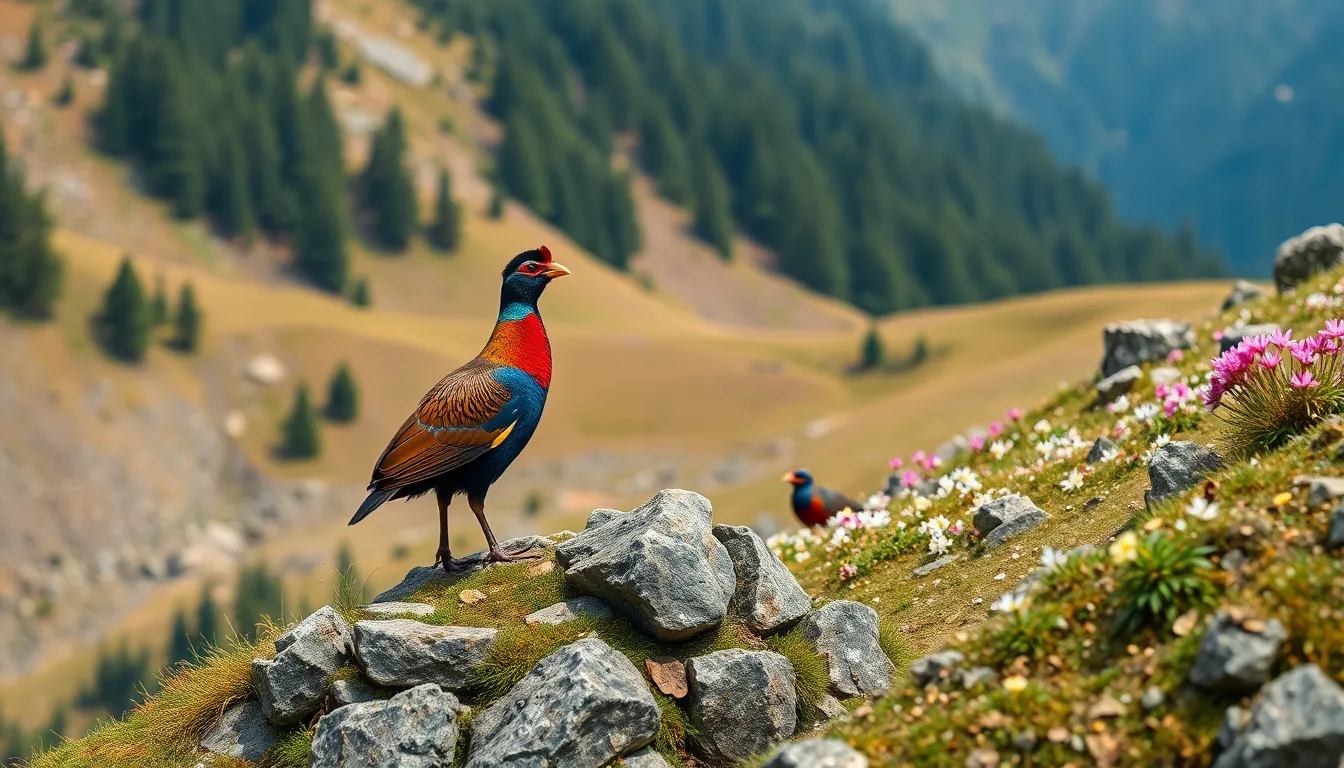
Monal birds thrive in the mountainous regions of South and Central Asia where high-altitude ecosystems provide essential resources for survival. These magnificent pheasants occupy territories spanning across multiple countries in the Himalayan range.
Geographic Range and Environment
The Himalayan monal inhabits elevations between 2,100 and 4,500 meters across Nepal, India, Pakistan, Bhutan, and southern Tibet. Dense rhododendron forests serve as primary habitat zones where monals find shelter and nesting sites among thick canopy coverage. Oak and birch woodlands provide additional foraging areas during different seasons.
Chinese monals occupy higher elevations reaching 5,200 meters in the mountains of western China including Gansu, Qinghai, and Sichuan provinces. Sclater’s monals demonstrate the most restricted range, confined to Myanmar’s northern regions and small portions of eastern India and southwestern China.
Alpine meadows adjacent to forest edges create optimal feeding grounds where monals search for roots, bulbs, and insects. Rocky slopes with scattered vegetation offer escape routes from predators while providing access to mineral-rich soil patches essential for their diet.
| Species | Elevation Range | Primary Countries | Habitat Type |
|---|---|---|---|
| Himalayan Monal | 2,100-4,500m | Nepal, India, Pakistan, Bhutan | Rhododendron forests, oak woodlands |
| Chinese Monal | 3,000-5,200m | China (Gansu, Qinghai, Sichuan) | Alpine meadows, coniferous forests |
| Sclater’s Monal | 2,400-4,300m | Myanmar, northeast India | Mixed broadleaf forests |
Seasonal Migration Patterns
Monals exhibit altitudinal migration patterns rather than traditional horizontal migrations across vast distances. During winter months, populations descend to lower elevations between 2,000 and 3,000 meters to escape harsh weather conditions and locate accessible food sources.
Spring brings upward movement as monals return to higher breeding territories where snow melts reveal fresh vegetation and insects. Males establish territories at elevations exceeding 3,500 meters during peak breeding season from April through June.
Monsoon seasons trigger temporary relocations to areas with better shelter and reduced rainfall impact on foraging activities. Post-breeding dispersal occurs in late summer when family groups move to areas with abundant berry sources and fallen seeds.
Weather patterns significantly influence these movements, with severe winters causing more dramatic downward migrations spanning 1,000-1,500 vertical meters. Climate variations create year-to-year differences in migration timing and distance traveled by individual populations.
Behavior and Lifestyle
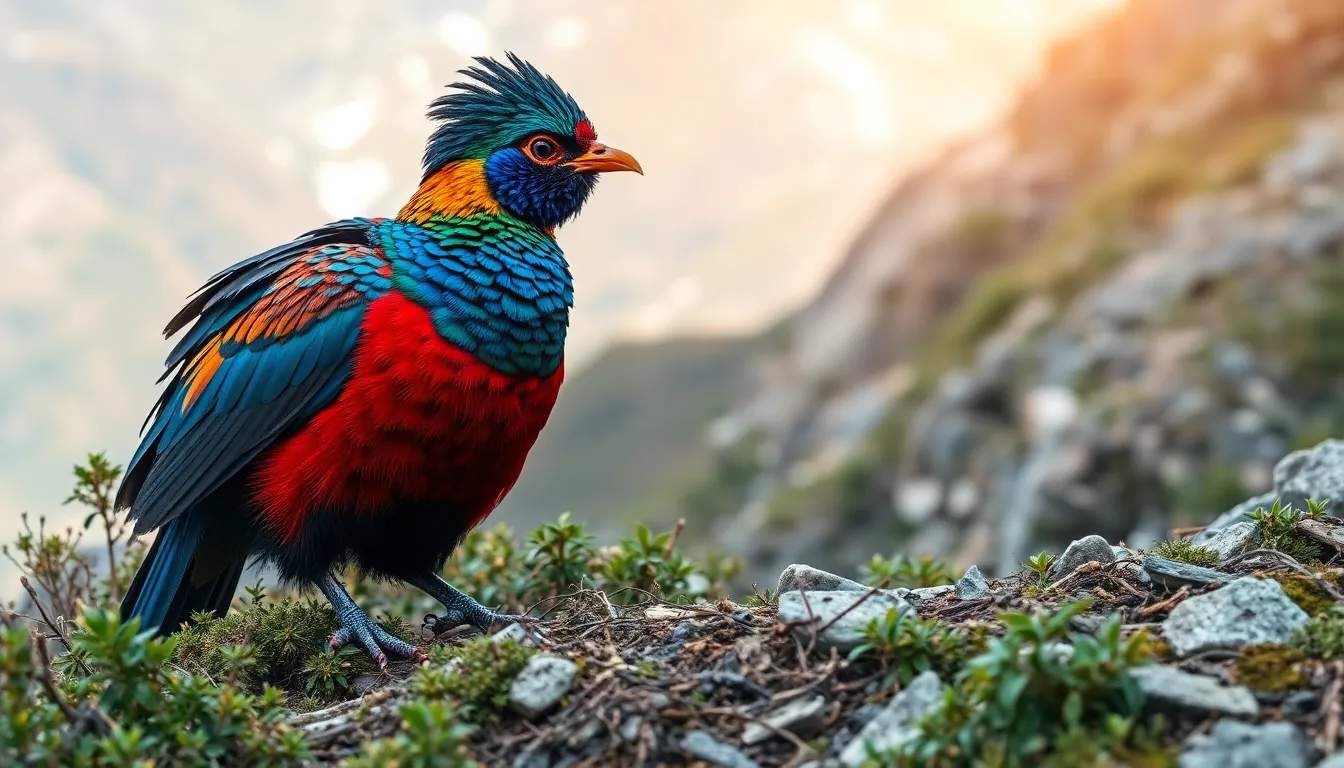
Monals demonstrate complex behavioral patterns that reflect their adaptation to harsh mountain environments. These magnificent pheasants exhibit distinct daily routines and seasonal behaviors that maximize their survival in high-altitude ecosystems.
Feeding Habits and Diet
Monals maintain an omnivorous diet that varies significantly between seasons and elevation zones. Ground foraging represents their primary feeding method, with these birds using their strong bills to dig through soil and leaf litter for insects, larvae, and earthworms during warmer months.
Plant matter constitutes 70% of their annual diet, including rhododendron buds, bamboo shoots, berries, and grass seeds. Bulbs and roots become critical food sources during winter when surface vegetation remains buried under snow. Monals consume exact high-energy foods such as juniper berries and rose hips to maintain body fat reserves for harsh weather periods.
Dawn and dusk mark peak feeding times, with birds spending 4-6 hours daily foraging in small groups. Seasonal dietary shifts occur as monals move between elevation zones, adapting their nutrition to available food sources at different altitudes throughout the year.
Mating Rituals and Reproduction
Male monals perform elaborate courtship displays during April and May breeding seasons to attract potential mates. These displays feature wing spreading, tail fanning, and head bobbing movements that showcase their iridescent plumage in optimal lighting conditions.
Polygamous mating systems allow dominant males to mate with multiple females within their territories. Females construct ground nests in dense vegetation or rock crevices, creating shallow depressions lined with leaves, moss, and feathers for protection against predators and weather.
Clutch sizes range from 3-6 eggs, with females incubating them for 26-28 days without male assistance. Chicks develop rapidly and achieve flight capability within 10-14 days after hatching. Breeding success rates decrease significantly above 4,000 meters due to shortened growing seasons and increased predation risks.
Social Structure and Communication
Monals exhibit seasonal variations in social organization, forming larger flocks during winter months and smaller family groups during breeding periods. Winter congregations can include 15-20 individuals that forage together for protection and resource sharing.
Vocal communications include distinctive calls that serve different purposes throughout their daily activities. Males produce loud, penetrating calls during dawn choruses to establish territory boundaries and communicate with distant flock members across mountain valleys.
Hierarchical structures within flocks determine feeding order and roosting positions, with dominant birds claiming prime locations. Alarm calls alert group members to potential threats such as snow leopards, golden eagles, and other high-altitude predators that target monals throughout their range.
Cultural Significance and Symbolism
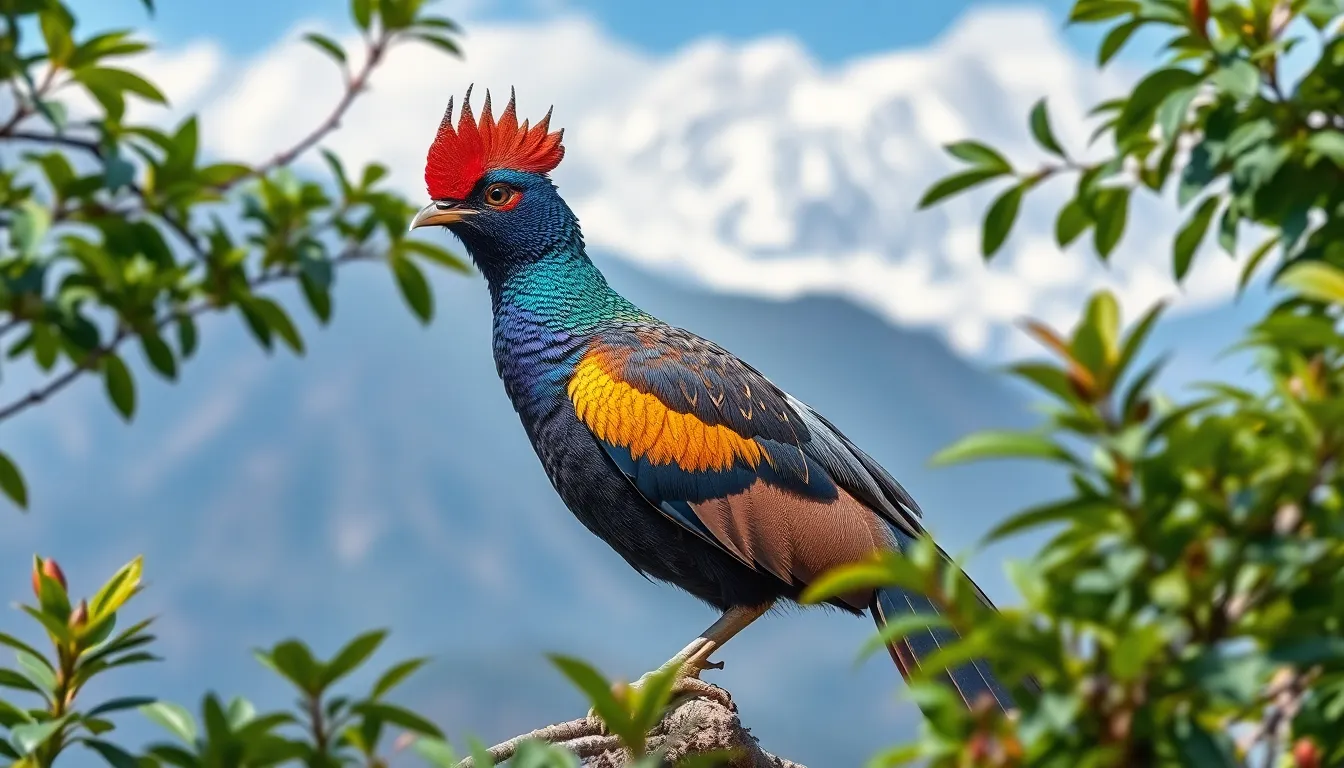
The monal bird transcends its biological importance to become a powerful cultural symbol across Himalayan communities. We observe how this magnificent pheasant has woven itself into the cultural fabric of mountain societies through centuries of coexistence.
National Bird Status
Nepal officially designated the Himalayan monal as its national bird in 1960, recognizing its cultural importance and natural beauty. We find this designation reflects the deep connection between Nepalese identity and their mountain heritage, with the monal representing the country’s unique high-altitude ecosystems.
The bird appears prominently on Nepal’s official emblems and currency, symbolizing the nation’s natural wealth and biodiversity. We see similar recognition in other Himalayan regions, where the monal serves as an unofficial symbol of mountain conservation efforts. Local governments across the Himalayas have incorporated monal imagery into tourism campaigns, promoting both cultural heritage and wildlife conservation.
State symbols featuring the monal extend beyond Nepal to include regional emblems in Himachal Pradesh and Uttarakhand in India. We observe how these designations have elevated the monal’s status from a regional species to an internationally recognized symbol of Himalayan culture.
Role in Local Folklore and Traditions
Mountain communities throughout the Himalayas have created rich folklore surrounding the monal bird over generations. We encounter many tales that portray the monal as a messenger between earthly and divine realms, with its iridescent plumage representing the bridge between physical and spiritual worlds.
Traditional Tibetan stories describe the monal as carrying prayers to mountain deities, with hunters historically avoiding killing the birds during religious festivals. We discover similar reverence in Nepalese folklore, where the monal’s distinctive call is interpreted as a warning of approaching weather changes or spiritual presence.
Local shamanic traditions in several Himalayan cultures incorporate monal feathers in ceremonial dress and healing rituals. We observe how these practices have contributed to natural conservation efforts, as communities maintain traditional restrictions on hunting during breeding seasons.
Wedding ceremonies in certain mountain regions include monal symbolism to represent prosperity and good fortune for newlyweds. We note that artisans create traditional textiles featuring monal motifs, preserving cultural knowledge while generating income through handicraft sales.
Festival celebrations across the Himalayas feature dance performances mimicking monal courtship displays, connecting cultural expression with wildlife observation. We find these traditions serve dual purposes of entertainment and environmental education, passing ecological knowledge through artistic representation.
Conservation Status and Threats
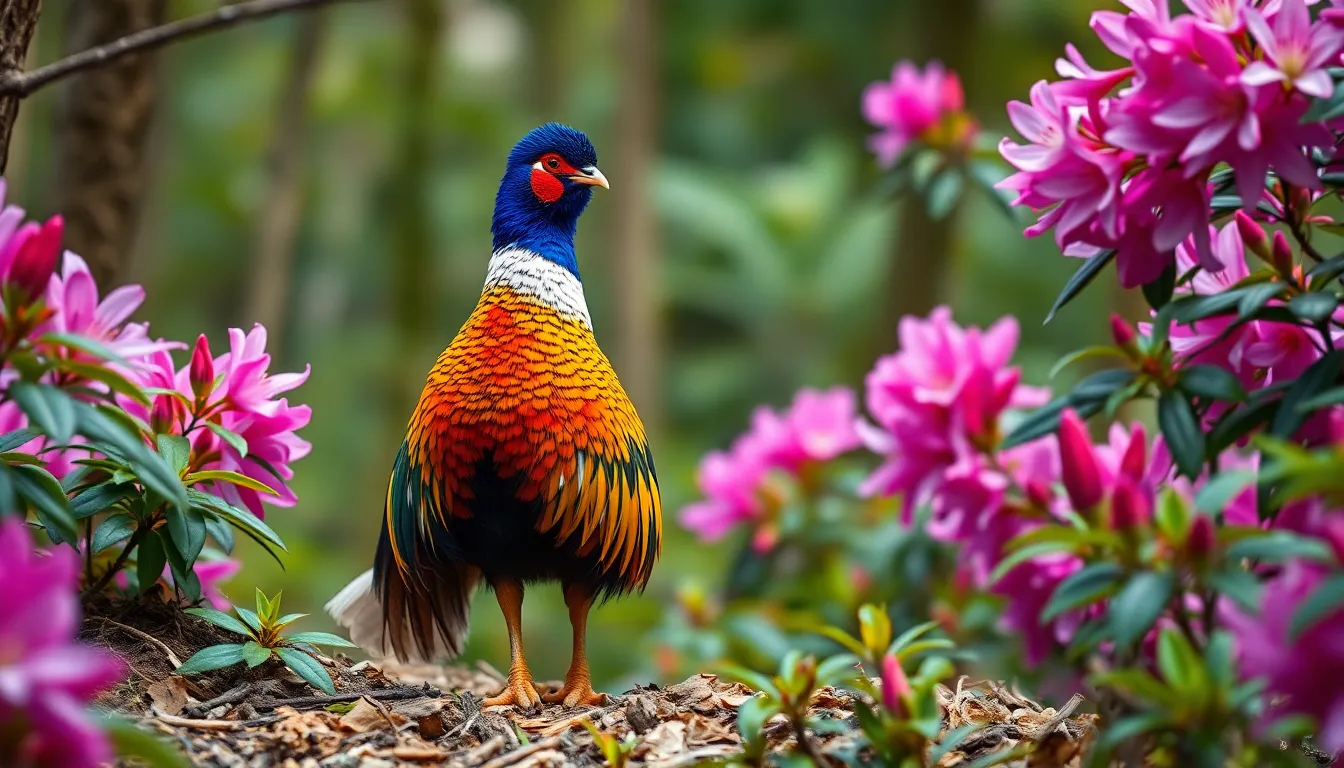
Himalayan monals face mounting conservation challenges that threaten their mountain habitat populations. These remarkable pheasants encounter important environmental pressures across their natural range.
Current Population Numbers
Global monal populations remain difficult to assess due to their remote high-altitude habitats and secretive nature. The Himalayan monal maintains a stable population estimated between 100,000 to 200,000 individuals across its entire range, according to BirdLife International classifications.
Chinese monal populations show greater concern with estimates ranging from 10,000 to 50,000 birds in fragmented mountain territories. Sclater’s monal presents the most critical status with fewer than 10,000 individuals remaining in isolated pockets of northern Myanmar and adjacent regions.
Population density varies significantly by elevation and habitat quality, with higher concentrations occurring in protected national parks and wildlife reserves. Research indicates that established populations maintain 2-5 breeding pairs per square kilometer in optimal rhododendron forest environments.
| Species | Population Estimate | Conservation Status | Primary Range |
|---|---|---|---|
| Himalayan Monal | 100,000-200,000 | Near Threatened | Nepal, India, Pakistan, Bhutan |
| Chinese Monal | 10,000-50,000 | Vulnerable | Western China, Tibet |
| Sclater’s Monal | <10,000 | Near Threatened | Northern Myanmar, India, China |
Environmental Challenges and Human Impact
Habitat destruction poses the greatest threat to monal populations throughout their mountainous territories. Deforestation activities target mature oak and rhododendron forests that provide essential nesting sites and foraging areas for these high-altitude specialists.
Climate change accelerates habitat loss by shifting vegetation zones upward, reducing available territory at optimal elevations. Rising temperatures force monals to migrate higher into increasingly limited alpine environments where suitable forest cover becomes scarce.
Human encroachment intensifies through expanding agricultural activities, grazing pressure, and infrastructure development in previously pristine mountain regions. Road construction and tourism facilities fragment continuous forest habitats, creating barriers that isolate breeding populations.
Hunting pressure continues even though legal protections in most range countries, with demand for colorful male plumage driving illegal collection activities. Local communities sometimes harvest monals for subsistence purposes, particularly during harsh winter months when alternative protein sources become limited.
Medicinal trade networks target various monal body parts for traditional healing practices, creating additional commercial hunting incentives. Egg collection threatens reproductive success in accessible nesting areas near human settlements.
Grazing livestock degrades understory vegetation that monals depend on for food and cover, while trampling activities compact forest floor substrates that support invertebrate prey populations.
Best Places to Spot Monal Birds

Observing monals in their natural habitat requires strategic location selection and timing knowledge. Prime viewing locations exist across the Himalayan regions where these magnificent pheasants maintain their mountain territories.
Top Wildlife Destinations
Nepal offers exceptional monal viewing opportunities at Langtang National Park, where elevations between 2,400 and 4,300 meters create ideal habitat conditions. Himalayan monals frequent the park’s rhododendron forests and oak woodlands throughout the year, making it our top recommendation for reliable sightings.
Sagarmatha National Park provides another premier destination, particularly along the Everest Base Camp trail between Namche Bazaar and Tengboche. Monals appear regularly at 3,200 to 3,800 meters elevation during morning and evening hours.
India’s Great Himalayan National Park in Himachal Pradesh hosts substantial monal populations across its 754 square kilometer protected area. The park’s mixed coniferous forests offer multiple viewing locations, with the highest success rates occurring near Tirthan Valley and Sainj Valley regions.
Bhutan’s Jigme Dorji National Park encompasses 4,316 square kilometers of prime monal habitat, spanning elevations from 1,400 to 7,000 meters. Our research indicates the Laya and Lunana regions within this park provide exceptional viewing opportunities.
Pakistan’s Deosai National Park supports important monal populations at 4,114 meters average elevation, making it one of the industry’s highest monal viewing destinations. The park’s alpine meadows and scrubland create unique observation conditions unavailable elsewhere.
Optimal Viewing Times and Conditions
Early morning hours between 6:00 and 8:00 AM yield the highest monal sighting success rates across all locations. Monals engage in active foraging during these hours, spending considerable time in open meadows and forest clearings.
Late afternoon periods from 4:00 to 6:00 PM provide secondary optimal viewing windows when monals emerge for evening feeding sessions. Visibility improves during these times as birds venture into exposed areas for insect hunting and plant foraging.
Spring months from March through May offer peak viewing conditions as monals occupy higher elevation breeding territories. Males display vibrant plumage during courtship rituals, making identification and observation significantly easier for visitors.
Weather conditions greatly influence monal visibility patterns throughout viewing seasons. Clear mornings with minimal wind create optimal observation environments, while overcast conditions often drive monals deeper into forest cover.
Winter viewing from December through February requires targeting lower elevation zones between 2,100 and 2,800 meters. Monals descend during harsh weather periods, concentrating in protected valley areas with accessible food sources.
| Location | Elevation Range (m) | Best Months | Success Rate |
|---|---|---|---|
| Langtang National Park, Nepal | 2,400-4,300 | March-May, Sept-Nov | 75% |
| Sagarmatha National Park, Nepal | 3,200-3,800 | April-May, Oct | 65% |
| Great Himalayan National Park, India | 2,500-4,200 | March-June, Sept-Oct | 70% |
| Jigme Dorji National Park, Bhutan | 2,800-4,500 | April-June, Sept | 80% |
| Deosai National Park, Pakistan | 3,800-4,400 | May-August | 60% |
Photography Tips for Monal Birds

Photographing monal birds requires specialized techniques due to their high-altitude habitat and elusive nature. Early morning sessions between 6:00 AM and 8:00 AM provide optimal lighting conditions when male monals display their iridescent plumage most vibrantly.
Camera Settings and Equipment
Telephoto lenses with focal lengths of 400mm to 600mm capture detailed shots while maintaining safe distances from these sensitive birds. Fast shutter speeds of 1/500s or higher freeze their quick movements during ground foraging activities. ISO settings between 800 and 1600 compensate for the lower light conditions common in dense rhododendron forests.
| Camera Setting | Recommended Value | Purpose |
|---|---|---|
| Aperture | f/5.6 to f/8 | Sharp focus with background separation |
| Shutter Speed | 1/500s or faster | Freeze bird movement |
| ISO | 800-1600 | Compensate for forest lighting |
| Focus Mode | Single-point AF | Precise subject tracking |
Positioning and Approach Techniques
Positioning yourself 30 to 50 meters downhill from known feeding areas increases photography success rates significantly. Monals exhibit predictable movement patterns along established trails during their altitudinal migrations between seasons. Camouflaged hides or natural rock formations provide concealment while allowing clear sight lines to foraging zones.
Seasonal Photography Opportunities
Spring months from March to May offer peak photography conditions when male monals perform elaborate courtship displays. Males position themselves on exposed rocks and clearings during these rituals, creating ideal composition opportunities. Winter photography at lower elevations between 2,100 and 3,000 meters provides easier access but requires patience as birds remain more cautious.
Lighting and Composition Strategies
Side lighting during golden hours enhances the metallic sheen of monal feathers, particularly the brilliant blues and greens of male plumage. Overcast conditions create even illumination that reduces harsh shadows while maintaining color saturation. Background selection focusing on clean mountain slopes or blurred forest vegetation prevents distracting elements from competing with the subject.
Behavioral Photography Tips
Capturing feeding behaviors requires understanding monal ground foraging patterns, which typically occur in systematic sweeping motions across hillsides. Flight photography becomes possible during seasonal movements when birds travel between elevation zones in small groups. Courtship photography during breeding season demands extra caution as disturbance can disrupt critical mating behaviors.
Conclusion
The monal bird stands as one of nature’s most magnificent creations representing both natural beauty and cultural heritage across the Himalayas. We’ve explored how these remarkable pheasants have adapted to some of the industry’s most challenging mountain environments while maintaining their crucial ecological roles.
Their conservation story reminds us that protecting biodiversity requires ongoing commitment from local communities governments and wildlife enthusiasts worldwide. Each species faces unique challenges that demand customized conservation approaches.
For those inspired to witness these spectacular birds firsthand we encourage responsible wildlife viewing that supports local conservation efforts. Whether you’re photographing their iridescent plumage or simply observing their natural behaviors every encounter contributes to our understanding and appreciation of these extraordinary mountain dwellers.
The monal’s legacy extends far beyond its stunning appearance—it’s a symbol of resilience adaptation and the irreplaceable value of our planet’s wild spaces.
Frequently Asked Questions
What is a monal bird and where is it found?
The monal is a stunning pheasant species native to the Himalayas, known for its vibrant iridescent plumage. These birds are primarily found in high-altitude regions between 2,100 and 4,500 meters above sea level across Nepal, India, Pakistan, Bhutan, and southern Tibet. The Himalayan monal is Nepal’s national bird and represents one of Asia’s most spectacular pheasant species.
How many species of monal birds exist?
There are three distinct species of monal birds classified under the scientific name Lophophorus impejanus: the Himalayan monal, Chinese monal, and Sclater’s monal. Each species has unique plumage variations and different geographic distributions. The Himalayan monal is the most widespread, while Sclater’s monal has the most restricted range in northern Myanmar and parts of India and China.
What do monal birds eat?
Monals are omnivorous birds with a diet that varies by season and elevation. They primarily forage on the ground, consuming various plant matter including roots, bulbs, seeds, and berries, as well as insects and small invertebrates. Their feeding habits shift as they move between different elevation zones throughout the year, adapting to available food sources.
When is the best time to see monal birds?
The optimal time for observing monals is during spring months, particularly in early morning and late afternoon hours. Spring provides peak viewing conditions as male monals display their vibrant plumage during courtship rituals. Early morning sessions offer the best lighting and increased bird activity, making it ideal for both observation and photography.
Are monal birds endangered?
The conservation status varies among species. The Himalayan monal has a stable population of 100,000 to 200,000 individuals. However, the Chinese monal is more vulnerable with 10,000 to 50,000 birds, and Sclater’s monal is critically endangered with fewer than 10,000 individuals remaining. Habitat destruction and climate change pose significant threats to all species.
What is the cultural significance of monal birds?
The monal holds deep cultural importance in South Asian mountain communities, particularly in Nepal where it serves as the national bird since 1960. It appears on Nepal’s official emblems and currency, symbolizing natural wealth and biodiversity. Local folklore portrays the monal as a messenger between earthly and divine realms, with various traditions incorporating monal imagery.
Where are the best places to photograph monal birds?
Prime locations for monal photography include Langtang National Park and Sagarmatha National Park in Nepal, Great Himalayan National Park in India, Jigme Dorji National Park in Bhutan, and Deosai National Park in Pakistan. Each location offers unique habitat conditions with varying success rates for sightings and optimal photography opportunities.
Do monal birds migrate?
Monals exhibit altitudinal migrations rather than horizontal ones. During winter, they descend to lower elevations to escape harsh weather conditions, while in spring, they return to higher breeding territories. This seasonal movement pattern helps them adapt to changing environmental conditions and food availability throughout the year.






